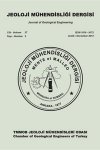
ABSTRACT: In terms of geological engineering, tunnel design in weak rock masses presents some challenges.A small misinterpretation in the design stages can lead to costly and time-consuming problems at theconstruction phases. To avoid serious problems of these kinds, tunnels excavated in weak rock massesshould be projected with the most suitable and economical excavation method in design stage. In thisstudy, stability of the thin-bedded marls belong to Paleocene aged Şenkaya Sırtı formation, outcropped onthe route of Cankurtaran (Hopa-Artvin) tunnel, was investigated using empirical and numerical methods.Firstly, the properties of the discontinuities in the marls and geomechanical parameters of intact rockmaterial were determined based on the description criteria of ISRM (1981). In the next stage, marlswere classified by using the RMR, Q and GSI systems and rock mass properties were determined. In thefinal stage, the stability of the tunnel, planned to be excavated in the marls, was investigated by usingthe criterion of Singh et al. (1992), Goel et al. (1995), Bhasin and Grimstad (1996) and Finite ElementMethod (FEM). As a result of the analyses, it was concluded that the factor of safety value varies between0.08 and 1.43 and there may be a risk of instability problem in the tunnel.
ABSTRACT: It is important from the economy point of view to be able to estimate the mean block volume obtainablefrom a rock mass in block stone quarrying operations. In the first stage of this study, the mean blockvolumes likely to be obtainable from the Mesozoic limestone quarries of the Karaburun Peninsula areestimated by analyzing the discontinuity measurements made in these quarries using the equation givenin literature. It has been found that the rock block designation method (BQD) proposed by the authorhas given closer results to the block volume values estimated using the volumetric joint count (Jv) as Vi= 36/Jv3 among the suggested block volume estimation method given in literature. In the second stage,the mean block volume (Vb), the volumetric joint count (Jvb) and the block shape factors (βb) values of2378 blocks produced from the working quarries of Karaburun Peninsula are compared with the meanblock volumes (Vi) and the volumetric joint counts (Jvi) estimated by using the field discontinuity spacingmeasurements. Relations are given for estimating the mean block volume producible from a quarry usingthe field discontinuity spacing measurements and they are presented as a graph for general use.
ABSTRACT: In the area of Kazanlı in Mersin, greenhouse cultivation and citrus production have been intensivelydone. There are several pollutant elements used for agriculture in these lands. Due to the petroleumfilling plants, factories and especially chromium mining, Kazanlı-Mersin Region has been exposed tothe wastes including toxic elements such as Cu, Zn, Mn, Cd and Pb for the last 25 years. The pollutionin the area can be observed as soil, plant, air, ground water, surface water and seawater pollutions. Theaim of this study is to investigate the biogeochemical anomalies and interpretation of the environmentalconditions. Samples of 19 plants types (16 natural, 3 plantation type), soil and water (stream, sea, wells)in the study area were systematically collected. The samples were analyzed for their Cu, Mn, Zn, Cd, Pbcontents using Atomic Absorption Spectrometer (AAS). The results of chemical analyses of the soil andplant samples have been evaluated statically for 5 elements and a linear relationship between plant andsoil has been determined for 3 elements. Leaves and twigs of Melilotus sp., leaves of Alhagi camelorum,leaves and twigs of Xanthium strumarium for Cu, leaves of Vicetoxicum parviflorum, leaves of Melilotussp., leaves and twigs of Alhagi camelorum, leaves of Salsola kali, leaves of Arundo donax, leaves andtwigs of Xanthium strumarium, leaves of Eucalyptus grandis for Mn, leaves of Melilotus sp., twigs ofPancratium and leaves and twigs of Arundo donax for Zn have been determined as indicator plants.Linear relationship between plant types and soil for the element levels of Pb and Cd is obtained. Elementcontents of plant and soil are above the normal levels for Mn and Zn. In this respect, plant and soil can beconsidered as polluted with these heavy metals in Kazanlı- Mersin area.
ABSTRACT: As the importance of planning and scheduling of a mining operation become apparent, there has beenan increasing use of sample data to estimate the grade and amount of material to be mined. Concordantlyimportance of reliable mineral resource and reserve estimations has increased. Since the start of themodern mining era by the JORC Code, there has been an increasing tendency to regulate estimationand public reporting of mineral resources and reserves. These codes do not attempt to regulate eitherthe method of estimation of the resource/ore reserve or the classification technique, but rather providea system for estimation and classification of tonnage and grade estimates according to geologicalconfidence and technical/economic considerations. These reporting standards are considered by stockexchanges and finance organizations to represent best practice and form the minimum standard for publicreporting of exploration results, mineral resources and ore reserves. The national reporting codes areinvolved in international negotiations on reciprocity of reporting definitions and standards which havebeen underway for some years and are still ongoing. Meanwhile, stock exchange listing rules now define arecognized mining professional in similar terms to a CP, except that the person must have membershipof a recognized overseas professional body that has agreed to sanction the person if the person does notcomply with rules. This review paper has been written to summarize the latest developments in mineralresource estimation and reporting practices, describe some best practices.

 TMMOB
TMMOB